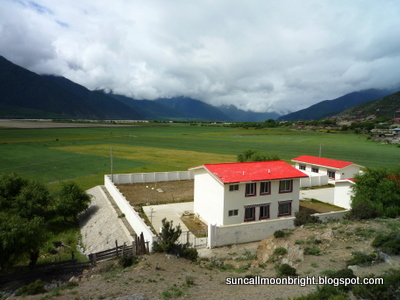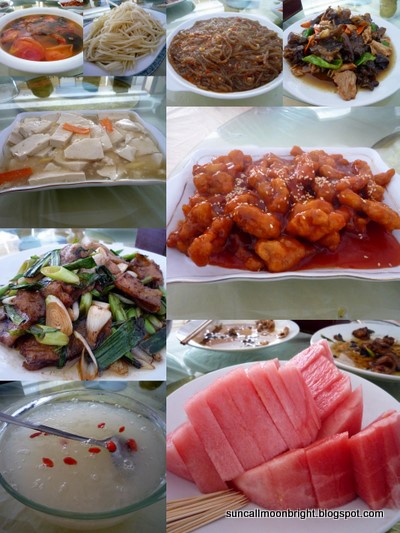View the previous post here or return to the trip index here.
31 May 2009
Woke up in the morning at an ungodly hour. We were off to the domestic airport in Chengdu to catch a morning 7:30am flight to Nyingchi (林芝, Lin Zhi), Tibet. At about 2990 metres, this will be the highest place I have been to so far. Also known as the Jiang Nan of Tibet, Nyingchi is covered with greenery and is the fruit and vegetable growing region for Tibet. Thanks to the flora, oxygen levels are approximately 80% that of sea level, making Nyingchi a good place to start touring Tibet.

No time for hotel breakfast this morning, it's buns and cups of coffee tea mix

Queueing to check in. With only one flight per day to Nyingchi, missing it means being stuck in Chengdu

Another breakfast on board, porridge

Arrival, thick low lying clouds everywhere! Okay perhaps not that low lying since we are so high up. Seems like the thick clouds is one of the reasons why there's only a single flight in the morning per day.

With one flight a day, I guess the airport staff only work in the mornings

The airport building, it's new, they screen your temperature inside and are very serious about not allowing the H1N1 virus to enter Tibet.
After collecting our luggage, we left to board the coach. Our local guide was a nice lady from Sichuan. We were each presented a white khata that looks like a white scarf for good fortune and greeted in Tibetan style, Za Shi De Le -- in Chinese meaning, 吉祥如意 Ji Xiang Ru Yi, good fortune.
On leaving the airport, we immediately had to show our passports and entry permit for Tibet to a military checkpoint right outside. Being a military controlled area, it is best not to take pictures of the soldiers here. One of the persons in our tour group did just that and instantaneously the military police had come on board our coach to ensure it was deleted. They are sharp, strict, and can detain you if they wish to.
On leaving the airport, we immediately had to show our passports and entry permit for Tibet to a military checkpoint right outside. Being a military controlled area, it is best not to take pictures of the soldiers here. One of the persons in our tour group did just that and instantaneously the military police had come on board our coach to ensure it was deleted. They are sharp, strict, and can detain you if they wish to.

A short way from the airport, we stopped by a river confluence for some scenic pictures

Scenic Spot

Clear waters, green mountains

Panorama of the spot


Another panorama, a pleasant breeze was blowing


Not sure what the piled rocks are for. The coloured papers are Buddhist scriptures. Tibetans believe that fluttering them in the wind is akin to reciting them.

Farmland. It seems great to be a farmer here, but the high altitude is bad for your health in the long term.

Yet another panorama, then it was time to go to our next stop


Tibetan fragrant pigs (藏香猪, zhang xiang zhu), it's said their meat is much better than normal pigs and don't come cheap

A local kid peeking behind the rocks

Some Tibetan houses. They don't all live in brick houses though, some of the herders live in tents

We arrived at the Bugyur Lamalin Temple (啦嘛岭寺, La Ma Ling Si), our first visit to a Tibetan Buddhist Temple. This temple is the most important in Nyingchi and belongs to the Red Hat Sect, the earliest Buddhist sect in Tibet.

Behind the main entrance were some Mani Wheels. A mantra is written on them and the Tibetans believe that spinning them round once is equivalent to a single recital of the mantra. It does not seem to bother what actually spins them, some even put the mantra on a computer hard disk and claim meritorious effect for recital.
Video of the Mani Wheels in action


The main temple building, unfortunately, they do not allow photos indoors

The entrance, elaborately decorated with painted wooden carvings

I guess these are guardians

There are three levels and we have to negotiate the steep steps slowly. Most of us did not feel the effects of high altitude yet as it takes about six hours for the oxygen levels in our blood to decline. Over exertion during this time may induce altitude sickness later.

Large beads hanging at the top of the temple

Panorama from the top


A goat, traditionally, vegetables is scarce in Tibet so everyone including the Lamas take meat

The phallus, it seems there is genitilia worship imported from India here.

Yet another phallus

Leaving the temple, we made a short stop to take pictures of the canola flowers in full bloom. These are used for cooking oil.

Panorama of the canola flower beds


Arrival at Ba Yi Town (八一镇, Ba Yi Zhen), literally eighty one town. This town was originally built by the Eighty First PLA that liberated Tibet and have a strong presence in the surroundings here. It's neatly organised and very clean.

Our lunch stop

Lunch, most of the Han Chinese settlers here come from Sichuan, so all Chinese cooking is Sichuan cruisine

Our hotel, the Fujian Hotel, built with money from the Fujian province. They have a scheme whereby the richer eastern coastal provinces give money to the western provinces to develop them.

Nice sitting area, there aren't many visitors around

Our hotel room

Canister of oxygen in case we get a sudden bout of altitude sickness

A snowy mountain from our hotel room window

The local meteorological station


The streets outside our hotel, wide and spacious

Blog Bar, when asked if they have internet access, they said there are just a cafe. What a misleading name!

With low traffic, most of the intersections are circles without traffic lights

The rest of the day passed with us resting in the hotel and getting our bodies adjusted to the high altitude. Before long, it was dinner

A scrumptuous dinner!
Some of the things we had to take note off included not bathing on the first day up in the highlands in case of over-exertion. We were also advised to leave the bathroom door ajar to allow oxygen in and for our partner to check on us in case we faint during our bath. Other interesting things included the effects of low pressure that comes along with the lack of air. Water boils at 80 degree celcius instead of 100 and is extra "jumpy" when boiling, we had to fill our kettles about 2/3 full. Consequently, rice and noodles here are cooked using pressure cookers. Creams we brought along start to shoot out of their tubes when opened, soft drinks became flat almost instantaneously when poured, and all bagged chips come bloated. Vehicle suffer from altitude sickness as well, with less oxygen for petrol combustion. Seems like the Japanese models are the best and everyone is using them here.
With nothing much else to do for the rest of the day, we took an early night's rest. Tomorrow we will be visiting Basong Lake, a scenic freshwater lake with an island in the middle.
View the next related post here. Return to the trip index here.
With nothing much else to do for the rest of the day, we took an early night's rest. Tomorrow we will be visiting Basong Lake, a scenic freshwater lake with an island in the middle.
View the next related post here. Return to the trip index here.
No comments:
Post a Comment